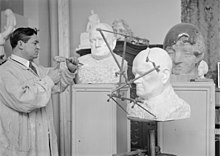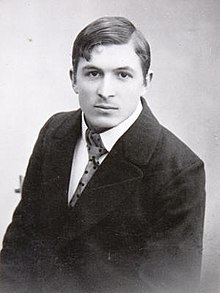Wäinö Aaltonen

Wäinö Waldemar Aaltonen , also Väinö Waldemar Aaltonen [ ˈvæi̯nœ ˈɑːltɔnɛn ] (born March 8, 1894 in Marttila , † May 30, 1966 in Helsinki ) was a Finnish sculptor . He mainly created monuments and portrait busts, but also reliefs, medals, landscape drawings and oil paintings.
life and work
Wäinö Waldemar Aaltonen was the son of a village tailor and a woman of peasant descent. As a four-year-old child, he became permanently deaf. From 1910 to 1915 he studied drawing and painting with the Finnish landscape painter Victor Westerholm at an art school in Turku . He then taught himself the skills in the field of sculpture, in which he was to develop particular talent, and subsequently worked with granite in particular, but also with marble, bronze, plaster and wood. He presented his early sculptures at an exhibition in Turku in 1916. From now on he received various scholarships and held an exhibition of his works in Helsinki in 1918, where he had moved the previous year. As an important early work he created the granite boy (1917-20), which is in the Ateneum art museum in Helsinki.
Aaltonen undertook several extensive study trips to various European countries, first to Italy in 1923. His bronze statue of the Finnish athlete Paavo Nurmi , made in 1924, became particularly well known , one of which is in front of the Olympic Stadium in Helsinki and another in Turku. In the following year 1925 he traveled to France and England for study purposes. In the second half of the 1920s he also received inspiration from Cubism in his artistic work , which can be seen, for example, in the work "The Dancer" (Aaltonen Museum, Turku) created in 1928. During the same period he studied ancient and renaissance sculptures and made gilded wooden sculptures, around 1925 the "Girl's Head" exhibited in the Ateneum Museum in Helsinki.
The style of Aaltonen's main work is characterized by the simplification of forms and a certain tendency towards monumentality. His reputation as the leading sculptor in Finland in the inter-war period , who also enjoyed international fame, came from his memorials to soldiers, important Finnish personalities and the embodiment of the ideas of the independence of the Finnish republic, which was founded in 1917. For example, he created monuments for the Finnish writer Aleksis Kivi in Tampere (1926-27) and Helsinki (Ateneum Museum, 1932-34) and five statues for the Senate Chamber of the Reichstag building 1930-32. He also erected a memorial titled “The Storm” for the victims of a submarine sinking in Reposaari from 1929-30 . His marble relief "The goddess of freedom wreaths the youth", created in 1938-40 at the University of Helsinki, was destroyed in an air raid in 1944. Another well-known work is his Memorial to the Finnish Settlers in Delaware (1938).
After the Second World War , Aaltonen undertook a study trip through the United States in 1952 and placed the grave monument for the Finnish field marshal and President Gustaf Mannerheim (1953) in the military cemetery in Hietaniemi , numerous war memorials (around 1954 in Rovaniemi) and a larger than life bust of Johannes Gutenberg (1962), which can be viewed in Mainz .
Other works by Aaltonen include the portrait of the national composer Jean Sibelius exhibited in the Konstmuseum in Gothenburg ( Sweden ) and the statue of the Finnish composer and conductor Toivo Kuula in Vaasa . He was able to win numerous prizes such as the Grand Prix at the Paris World Exhibition in 1937 , was a member or honorary member of many associations and academies and received, among other things, the order of the Légion d'honneur . He also received honorary doctorates from the Universities of Lund (1941) and Helsinki (1950).
Matti Aaltonen, a son of the artist, who died in 1966, designed the Wäinö Aaltonen Museum in Turku, which opened in 1967, in memory of his father . This offers interested visitors an insight into the life and work of the Finnish sculptor.
literature
- M. Leinert: Aaltonen, Wäinö . In: General Artist Lexicon . The visual artists of all times and peoples (AKL). Volume 1, Seemann, Leipzig 1983, ISBN 3-598-22741-8 , p. 14 f.
- Leena Ahtola-Moorhouse: Aaltonen, Wäinö . In: Grove Dictionary of Art . Vol. 1 (1996), pp. 11f.
- Ludger Alscher et al .: Lexicon of Art. 1st volume. Publisher European book, West Berlin 1984, ISBN 3-88436-112-0
- Hans Vollmer : General Lexicon of the Visual Artists. Leipzig 1937/38, volume 1, p. 1.
Web links
- Wäinö Aaltonen Museum of Art (Finnish, Swedish and English versions)
Remarks
- ↑ M. Leinert: Aaltonen, Wäinö . In: General Artist Lexicon . The visual artists of all times and peoples (AKL). Volume 1, Seemann, Leipzig 1983, ISBN 3-598-22741-8 , p. 14.
| personal data | |
|---|---|
| SURNAME | Aaltonen, Wäinö |
| ALTERNATIVE NAMES | Aaltonen, Wäinö Waldemar (full name); Aaltonen, Väinö Waldemar |
| BRIEF DESCRIPTION | Finnish sculptor |
| DATE OF BIRTH | March 8, 1894 |
| PLACE OF BIRTH | Marttila |
| DATE OF DEATH | May 30, 1966 |
| Place of death | Helsinki |

